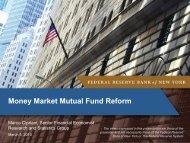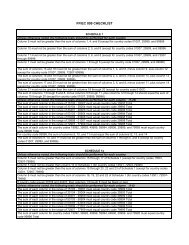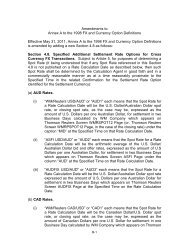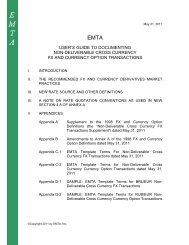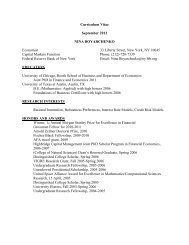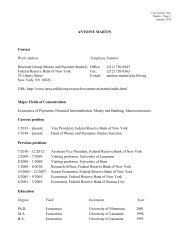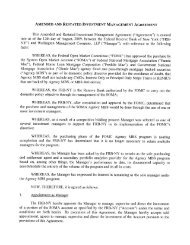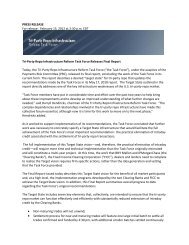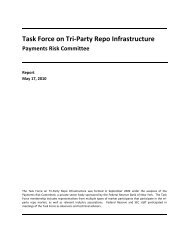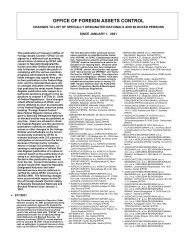Residential Foreclosures in the City of Buffalo, 1990-2000 - Federal ...
Residential Foreclosures in the City of Buffalo, 1990-2000 - Federal ...
Residential Foreclosures in the City of Buffalo, 1990-2000 - Federal ...
Create successful ePaper yourself
Turn your PDF publications into a flip-book with our unique Google optimized e-Paper software.
conventional loans were for a home purchase. <strong>Foreclosures</strong> on such loans likely grew<br />
significantly over <strong>the</strong> study period as well.<br />
The pattern <strong>of</strong> <strong>Buffalo</strong> foreclosures by loan type <strong>of</strong>fers evidence <strong>of</strong> an across-<strong>the</strong>-<br />
board <strong>in</strong>crease <strong>in</strong> fail<strong>in</strong>g mortgages, and suggests <strong>the</strong> diverse circumstances beh<strong>in</strong>d<br />
foreclosures. This po<strong>in</strong>t is emphasized by <strong>the</strong> manner <strong>in</strong> which <strong>the</strong> lend<strong>in</strong>g-related<br />
characteristics <strong>of</strong> foreclosures varied among <strong>Buffalo</strong>’s neighborhoods. Communities were<br />
found to differ <strong>in</strong> a number <strong>of</strong> ways, such as <strong>in</strong> <strong>the</strong> most prevalent type <strong>of</strong> foreclosed<br />
loan, <strong>the</strong> performance <strong>of</strong> loans, and <strong>the</strong> age <strong>of</strong> loans at foreclosure.<br />
Variation was especially evident <strong>in</strong> <strong>the</strong> two communities where foreclosures were<br />
most prevalent. In East Delavan, FHA purchase loans foreclosed at a rate substantially<br />
above <strong>the</strong> city average and accounted for almost half <strong>of</strong> all foreclosures. In <strong>the</strong> North East<br />
community, conversely, conventional purchase loans showed <strong>the</strong> worst performance.<br />
These f<strong>in</strong>d<strong>in</strong>gs suggest that despite socioeconomic, geographic, and o<strong>the</strong>r similarities,<br />
different phenomena are at work <strong>in</strong> <strong>the</strong>se two communities.<br />
As might be expected, we found a strong correlation between loan performance<br />
and <strong>in</strong>come, with lower <strong>in</strong>come communities show<strong>in</strong>g generally higher foreclosure rates<br />
than <strong>the</strong>ir higher <strong>in</strong>come counterparts. However, lower <strong>in</strong>come communities tended to<br />
have less lend<strong>in</strong>g, and thus relatively low concentrations <strong>of</strong> foreclosures. We also found<br />
foreclosures on subprime loans to be most concentrated <strong>in</strong> lower <strong>in</strong>come communities<br />
with large m<strong>in</strong>ority populations. This result is consistent with research show<strong>in</strong>g that<br />
subprime lend<strong>in</strong>g is more prevalent among m<strong>in</strong>orities. However, this association between<br />
subprime foreclosures and socioeconomic characteristics does not hold true <strong>in</strong> all cases.<br />
Also suggest<strong>in</strong>g concern is our f<strong>in</strong>d<strong>in</strong>g that almost 40 percent <strong>of</strong> loans foreclosed<br />
<strong>in</strong> <strong>2000</strong> were young loans that moved <strong>in</strong>to default <strong>in</strong> less than four years. While <strong>the</strong><br />
underly<strong>in</strong>g factors beh<strong>in</strong>d <strong>the</strong>se foreclosures are unclear, <strong>the</strong>ir prevalence suggests that<br />
<strong>the</strong> market <strong>in</strong>cludes a substantial portion <strong>of</strong> high-risk loans. This result also begs two<br />
important questions: What comb<strong>in</strong>ation <strong>of</strong> market forces, government policy, and o<strong>the</strong>r<br />
factors could be converg<strong>in</strong>g to create <strong>in</strong>centives lead<strong>in</strong>g to such circumstances? and How<br />
is <strong>the</strong> loss result<strong>in</strong>g from this risk be<strong>in</strong>g distributed among <strong>the</strong> borrowers, lenders,<br />
taxpayers, neighborhoods, <strong>the</strong> city, and society as a whole? But once aga<strong>in</strong>,<br />
notwithstand<strong>in</strong>g <strong>the</strong> high share <strong>of</strong> early foreclosures, more than 60 percent <strong>of</strong> loans were<br />
67



